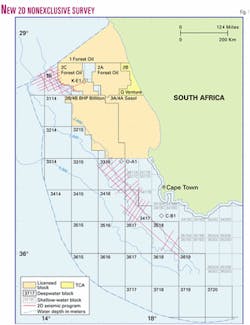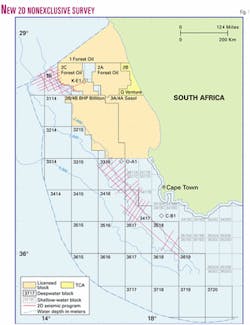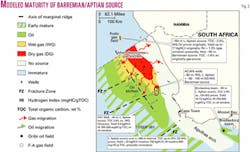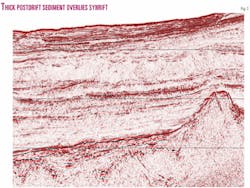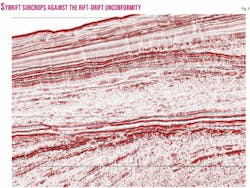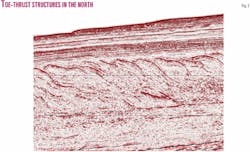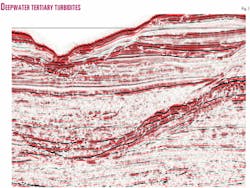Deepwater 2D data reveal new objectives off South Africa's west coast
Petroleum Geo-Services recently acquired a regional, 3,660 km nonexclusive 2D seismic survey over the deepwater Orange basin off the west coast of South Africa (Fig. 1).
From the coarse grid acquired over two separate provinces, the results have been extremely encouraging with numerous large structural and stratigraphic plays identified in conditions favorable for an active petroleum system in the deepwater Orange basin.
There is good prospectivity for both oil and gas over a range of water depths and at various stratigraphic levels, which augurs well for the success of future exploration off South Africa.
Both the synrift and post-rift successions are revealed to consist of a surprisingly thick sedimentary sequence that offers a variety of viable exploration objectives. The survey confirms the existence of a spectacular complex of growth fault and toe thrust structures developed in the northern part of the area. In addition, numerous seismic amplitude anomalies throughout the area highlight the presence of turbidite deposited drape sands and basin floor fans that may form traps within the Cretaceous and Tertiary sediments and enhance the hydrocarbon prospectivity.
With the deepwater Orange basin undrilled to date, the new seismic data provide strong encouragement for those exploration companies looking at this new and exciting deepwater province.
Exploration history
The Orange basin is defined by the extent of a Cretaceous and younger syn- to post-rift sedimentary wedge that occupies about 150,000 sq km off Africa's southwestern coast.
The most significant feature of the basin is the large sediment thickness that was deposited by the Orange and proto-Orange river systems in the northern depocenter of the basin, mostly to the south of the Namibian border. This huge complex of delta sediments is more than 8,000 m thick in places and overlies a Hauterivian unconformity that separates the earlier rift geology of this divergent volcanic margin from that of the younger drift period.1
Only 34 wells have been drilled to date in the South African sector of this huge basin, with all except one located shoreward of the 500-m isobath. Borehole O-A1 was drilled in 744 m of water and intersected the best quality source rock in the basin so far.2
Although the basin is so sparsely drilled, results thus far have been extremely encouraging. Two gas fields, Ibhubesi and Kudu, with multi-TCF potential have been discovered within the post-rift section, while the A-J1 well yielded an oil discovery in the earlier graben fill.
Ibhubesi gas field has recently been defined by Forest Oil International through appraisal drilling in the area of the original A-K1 discovery well. The tested wells in this field yielded a combined flow rate of 177 MMscfd of gas and 1,900 b/d of condensate. This gas and condensate is sourced from Lower Cretaceous source sequences and is held in stratigraphic and combination traps.
The reservoir interval comprises Albian sandstones deposited by a fluvial system within incised valleys, deposited during a major transgression that resulted in aerial exposure of the shelf. Porosities of these sands are as high as 20%, and permeabilities are excellent.
Analysis of 2D seismic data and a new 1,013 sq km 3D seismic survey in the area have defined many new prospects and justify the extension of this play for some distance to the north. Eight more appraisal wells will be drilled over the next two years, and a large development of what may prove to be a multi-TCF field is envisaged for the future. This development will be a first for the west coast of South Africa.
Kudu gas field lies to the north in the Namibian sector of the basin. In this large field, gas sourced from the Barremian interval is trapped in deep aeolian dune sandstones of the same age. Numerous appraisal wells have confirmed significant gas reserves associated with this field.
Waxy oil sourced from lacustrine claystones has been discovered trapped in lakeshore sandstones beneath the Hauterivian unconformity, within one of the isolated synrift half-grabens. Test results of the A-J1 discovery well are currently being reappraised, and the play is sure to receive further attention from explorers particularly given the thick development of the synrift sediments in the deep water.
Basin evolution
The break up of Gondwana between Africa and South America is thought to have begun in the late Jurassic with the southern west coast of Africa regarded as a divergent volcanic margin.34
Seaward-dipping reflector (SDR) sequences (thought to be composed of interbedded subaerially deposited volcanics and sediments) have been imaged on seismic data at various locations below the drift onset unconformity and within the transitional early Cretaceous. These tend to occur to the west of a medial hinge line and a well developed marginal ridge.
A number of large fracture zones trend perpendicular to the coastline and separate the margin into a number of crustal segments. The southernmost plate segment does not exhibit SDRs typical of volcanic margins and is more likely to be of the classic rifted margin type.3
To the east of the medial hinge line, synrift sediments fill a series of disconnected isolated half-grabens that parallel the present day coastline. The few well intersections of the graben sediments show them to be largely continental in nature, comprising fluvial and lacustrine sediments interbedded with volcanics.
A strong unconformity of Hauterivian age separates the synrift regime from a group of sediments that represent a period of transition between rifting and drift. This section comprises continental and shallow marine Barremian sediments, at times interbedded with volcanics.
By the early Aptian the margin was fully flooded as the South American and African plates finally disengaged, opening the margin to the southern ocean. This period also saw the development of major anoxia5 as seen in the northern parts of the South Atlantic and the deposition of basinwide source rocks of Barremian and early Aptian age.
After this, large prograding sequences continued to be deposited throughout the Cretaceous. Numerous cycles of regression and transgression during this period resulted in erosional unconformities. These unconformities bound sedimentary sequences comprising continental river-born material intermixed with open ocean sediments.
In the late Cretaceous and at a later stage during the Tertiary itself farther south, sediments at the shelf edges and slopes underwent major deformation due to sediment instability. These formed large growth fault and toe-thrust complexes, while sediments on the shelf remained undeformed. Tertiary sediments consist largely of calcareous oozes and carbonates.6
Deepwater plays
On the shelf in the area of the main basin depocenter of the Orange basin, the known source sequences are buried to great depth and are located well within the gas window. However, the post-rift sediment wedge thins to the west and south, and burial history modeling shows that in these areas the early Cretaceous source sequences mentioned above are likely to be in the oil window.
Based on trends observed in boreholes drilled across the shelf and the results of the DSDP 361 scientific borehole, these Aptian-Barremian source rocks are postulated to improve in quality becoming increasingly oil-prone away from the influence of the continental sediment bearing river systems.2 The coincidence of this improvement in quality with a general thinning of the sediment wedge suggests that the deeper water Orange basin could well be oil prone (Fig. 2).
While very little was known of the deepwater areas before the acquisition of the deepwater survey, some of the older vintage lines gave some idea of what could be expected. Jungslager6 first postulated a number of plays that might be expected in the deeper water sector of the basin from these lines. The new 2D data have confirmed and enhanced the understanding of these play types. These play types are best classified based on the potential source rock intervals.
Three main source rock intervals are identified in the Orange basin:
1.Synrift source rocks. These are of Late Hauterivian age and possibly Late Jurasssic to Neocomian. These occur in a number of basins that are truncated by the breakup unconformity updip.
2.Post-rift Barremian to lower Aptian source rocks. These are proven to charge Barremian age reservoirs as shown by the Kudu wells off Namibia where Aptian gas is stratigraphically trapped in aeolian sands of Barremian age. The Aptian has also proven to be an effective source in the Outeniqua basin, particularly the Bredasdorp subbasin where it sourced producing oil and gas fields.
3.Cenomanian to Turonian source rocks are generally believed to be predominantly terrestrial and gas prone in this region and have been immature where drilled in the basin. There is potential, however, for development of oil prone quality downdip and westward of the shelf break.
Jungslager6 also described an early post-rift play where Barremian-Aptian source rocks could charge deepwater turbidite sandstones ponded against the marginal ridge. Deepsea fan turbidite systems could also act as reservoirs in the Upper Cretaceous growth fault and toe-thrust belt that is found in the northern part of the basin.
Traps were seen to occur in the upper Cretaceous and Tertiary toe-thrust belts in the central part of the basin. Numerous channels are observed on the shelf data that would serve as conduits for turbidites carrying coarse-grained clastics from the shelf and slope environments into the deeper water.
Understanding deepwater
The new nonexclusive 2D survey acquired by PGS is split into two distinct programs.
One is an area in the north covered by 1,408 line km.
The other is a larger program in the south that consists of 2,250 line km (Fig. 1).
The new data confirmed the viability of the above speculative plays and revealed exciting new information that positively impacts on the prospectivity of the region.
The synrift succession in the area covered by the survey is thicker than expected and less isolated than the grabens inshore, while the post-drift sediment package in the south is far thicker and more extensive than originally thought (Fig. 3).
It has been possible to map the Hauterivian rift-drift and early Aptian unconformities across the entire data set. Laterally continuous high amplitudes occur regionally between these two unconformities. This is typical of the seismic signature of the early Cretaceous source sequences in both the Orange and the neighboring Bredasdorp basin2 and is extremely encouraging evidence for the existence of this source interval on a basinwide scale.
Traps imaged on the new data include structural, stratigraphic, and combination types. Possible structural traps occur within the large fault blocks of the synrift succession. In the shallower water areas of the survey, structural traps can be seen where shelf sediments have collapsed against fault closures. The toe-thrust province in the north provides several opportunities for the formation of structural traps.
A large number of stratigraphic-combination traps, in the form of high-amplitude channel turbidites and basin floor fans, have also been identified throughout the survey in both the Cretaceous and Tertiary.
Seismic data in the southern area have revealed localized intrusives that were not identified by magnetic data. There is a possibility that they are carbonaceous in nature or of some other composition that has a low magnetic signature. However, these intrusives are fairly uncommon, localized in extent, and have little impact on the prospectivity of the area.
Synrift prospectivity
The synrift section is extensively developed and is greater than 2 sec thick in places.
Large grabens are developed in the shoreward half of the northern area, which are bounded to the west by a zone dominated by volcanics. Large grabens are also evident in the northern part of the southern survey area. These grabens present opportunities for subcrop plays against the rift-drift unconformity (Fig. 4), while many structural closures have been identified in tilted fault blocks and in hanging walls.
The substantial thickness of synrift sediments revealed by the new survey has positive implications for the development of possible lacustrine source sequences by analogy with the oil-prone source rocks intersected in one of the shallow water grabens, as discussed above.
Post-rift prospectivity in Cretaceous
Many potential plays and traps can be seen on the new 2D data.
The early Cretaceous source rock-Barremian dune sand play is thought to be confined to the northern limit of the data. Encouraging high amplitudes can be seen below the early Aptian unconformity in this area.
Other plays within the deeper part of the section include onlaps and ponded turbidite deposits on the rift-drift unconformity.
Higher up in the section, strong amplitudes within rotated fault blocks and the toe-thrust areas (Fig. 5) imply that these plays may be prospective. Stratigraphic and-or combination plays occur in abundance throughout the survey area.
High amplitude fan features, often with diagnostic erosive bases, occur at many levels (Fig. 6). Some of these show abrupt dimming of amplitude at the edges, while others show convincing internal mounding. Several of these feature are ponded shoreward of or onlap onto a structural high that the seismic data show paralleling the coastline oceanward of the marginal ridge that was observed on older seismic in the southern area.
High amplitude channels form another play within the Cretaceous. These have obvious erosive bases, and reflectors clearly terminate against the sides. Some of these channels are overlain by sediments with a highly opaque seismic character (mudstones) which may well form a good seal.
Post-rift prospectivity in Tertiary
Several leads can be seen within the Tertiary in the southern part of the survey, where a large thickness of Tertiary section has been preserved.
All the possible traps identified are stratigraphic in nature, comprising high amplitude channels and fans (e.g., Fig. 7). These bodies demonstrate erosive bases, mounded internal geometries, and sudden terminations of bright amplitudes towards the edges, and may have (opaque) top seals.
References
1. Brown, L.F., Benson, J.M., Brink, G.J., Doherty, S., Jollands, A., Jungslager, E.H.A., Keenan, J.H.G., Muntingh, A., and van Wyk, N.J.S., "Sequence stratigraphy in offshore South African divergent basins, an atlas on exploration for Cretaceous lowstand traps," by Soekor (Pty.) Ltd., AAPG Studies in Geology 41, 1995.
2. van der Spuy, D., "Aptian source rocks in some South African basins," in Arthur, T.J., MacGregor, D.S., and Cameron, N.R., eds., "Petroleum Geology of Africa: New Themes and Developing Technologies," Geological Society, London, Special Publication, 2003.
3. Jungslager, E.H.A., "New geological insights gained from geophysical imaging along South Africa's western margin," extended abs., Saga/SEG Biennual Conference, Cape Town, 1999.
4. Lawrence, S.R., Munday, S., and Swart, R., "New concepts on Namibian margin evolution and bearing on petroleum prospectivity of offshore Namibia," abs. PESGB meeting on southern Africa and the Falklands, 1999.
5. O'Connell, S., and Wise, S.W., "Development of Mesozoic Organic-Rich Sedimentary Facies across Southwestern Gondwanaland Margins and Basins," AAPG Bull., Vol. 74, 1990.
6. Jungslager, E.H.A., "Petroleum habitats of the Atlantic margin of South Africa," in Cameron, N.R., Bate, R.H., and Clure, V.S., eds., "The oil and gas habitats of the South Atlantic," Geological Society, London, Special Publication 153, 1999, pp. 153-168.
Bibliography
PGS-Petroleum Agency SA internal report, "Prospectivity Review of the Western Orange Basin, South Africa," 2002.
The authors
David van der Spuy ([email protected]) has been area specialist for the northern west coast of South Africa for Petroleum Agency SA since 2001. Before that he was a geochemist with the agency and was an independent consultant in 1996-99. He holds degrees in management, geochemistry, and geology from College of South Africa and the University of Cape Town.
Nomthandazo Agnes Jikelo is principal geophysicist with Petroleum Agency SA, where she has been employed since 1995. She is a graduate of the University of Durban.
Thomas Ziegler has 13 years of upstream experience gained with oil operating, service, and consulting companies. He was a geologist with the UK new ventures group in Clyde Petroleum PLC before joining the PGS companies, where he has served since 1991. He has degrees in geology, remote sensing, and business and administration from Imperial College, University College, and Strathclyde Graduate Business School.
Matthew Bowyer is senior geologist with PGS Reservoir, which he joined in 1998. He was with Alastair Beach Associates Ltd. in 1996-98. He has provided geological input into all aspects of an integrated exploration and development team in South Africa and previously was part of a multidisciplinary team involved in a full reserves evaluation for a major operator in the North Sea. He has degrees in basin evolution and dynamics and geological sciences from the University of London and the University of Plymouth.
